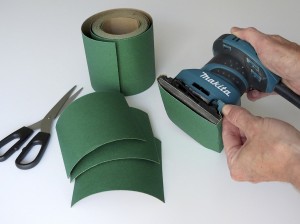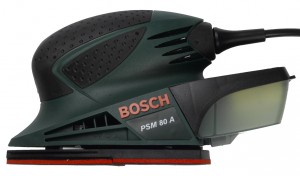Buying a sander
If you are in the market for buying a sander, this guide will tell you all you need to know about the best option for DIY. Power sanders, quite simply, make all those honing and preparation jobs so much easier. There are a number of different designs on the market, but I’ll explain why I think there is one stand out performer, and why I think that there are far too many different designs and shapes that are quite frankly, not needed, and will just gather dust in your shed. So firstly, a little more on sander types.
Half and quarter sheet sanders

With a palm sander you just cut sheets to size and they clamp very securely in place on the sanding pad. Rather than buying sandpaper sheets, I always opt for the rolls – it’s much cheaper, and more about this further down the page………..
Half sheet sanders were basically the original sander design, closely followed by their smaller cousin, the quarter sheet ‘palm’ sander.
Their names come from the fact that the sanding pad is either a quarter, or half the surface area of a standard sized sanding sheet.
I prefer the quarter sheet sander as firstly it’s light, and therefore not tiring to use.
Secondly, when you use a sander, however much you try to use the entire surface area of the sanding pad, you will always find that the most work is done by the front edge of the pad, closely followed by the back edge. The area in between doesn’t get involved as much as you would hope. Therefore because the front and back edges of a quarter sheet sander are the same size as those of a half sheet sander, I tend to think that buying the larger sanders is just a waste of sandpaper and machine alike.
Thirdly, the smaller sander is much easier to get into nooks and crannies and close up to corners – it’s just much more versatile.
Random orbital (RO) sanders
Things get slightly confusing here as the orbital sander category pretty much covers most sander designs these days, as it simply refers to the action of the sanding pad. Basically, the pad makes small random rotations to reduce any directional scratches in the surface, which would otherwise look unsightly in the finish. This is a particularly important consideration, for example, if you will be applying a translucent finish such as varnish or wax.
However, ‘Random orbital'(RO) is now a common description used for a particular variety of sander, and if you walked into a shop and asked for one, you would most likely be directed towards the sanders with the round sanding pads – small and large options. They are without doubt, nice pieces of kit, but the big ones are very pricy, heavy, and too big for the majority of jobs you need a sander for, and both sanders have what I think is the wrong design, in that they have round sanding pads. Maybe it’s just me, but I always need corners on my sander…… to get into corners – surely?
Belt sanders
Belt sanders have a strong sanding ‘belt’ fitted to a motor and pair of rotating drums, creating a pretty all round, powerful smoothing tool. However, for me, belt sanders are a pro tool, or only a requirement for serious woodworkers. Unless you do a lot of wooden floor laying, or have a compulsion to sand hundreds of oak beams, I never really feel you’re going to get your money’s worth out of them.
Belt sanders are heavy, unwieldy, and designed for real heavy-duty requirements, and you have to be very careful not to score surfaces as their weight and power can often cause you to gouge out, rather than smooth. I don’t own one, have very rarely used one, and therefore it certainly doesn’t spring to mind as an essential DIY tool.
Detail sanders

I know it’s cute, and this Bosch PSM80A is definitely the best detail sander on the market, but I just think that a standard palm sander is a much better, and cost effective option.
If there has ever been a very clever marketing drive for a pointless (please excuse the pun) piece of equipment, it has been the development of detail sanders.
Someone, somewhere said “I know, let’s make a cute looking power tool, and I reckon we can sell it on looks alone – oh yes and also, we can make special sized bits of sandpaper that only fit our machine…and oh yes, eventually people will get so hacked off, that they’ll stick it in a drawer, forget about it, and buy our next cute looking machine……” ….wait a couple of years….”bingo, I’ve got it boss, let’s make a cute little round sander, and we can start the whole process again!” i.e. see my comments earlier about the round RO sanders!
Now, if you’re saying to yourself……but surely the pointy sander has got the pointy bit that can get into corners better? Forgive me for pointing out the obvious, but a sander with a square sanding pad, such as quarter sheet palm sander, has four pointy corners! Also the design of a quarter sheet palm sander means that where the sandpaper curves around the end of the pad to be clamped in place, provides a perfect shape for running along the edge of a moulding, such as in a skirting board or along an architrave. Now I know detail sanders work, some better than others (!), but I just think why bother getting one when a quarter sheet sander will do the same job, and more, and in terms of running costs, below are a couple of calculations that should also be eye openers.
Sanding sheets
Before getting to my final choice, one further issue worth considering is the sanding sheets that you need for a sander, and the cost implications.
| Large round RO sanders – use a Velcro hook and loop system to attach disc shaped sanding sheets. | Pack of 10 for £5ish = 50p a go |
| Small detail sanders – also use a Velcro hook and loop system, for pointy shaped sheets. | Pack of 10 for £7ish = 70p go |
| Quarter sheet sanders – may use Velcro but you also have the option of clamping sheets in place. | 10m roll of aluminium oxide paper is £8ish. You then cut sheets to length – approx 15cm – 6 sheets per metre say = 60 sheets = 14p a go |
It’s just SO much cheaper to use a quarter sheet palm sander. As a side note, Â it’s also much better/economical to buy sandpaper in rolls, rather than sheets.
Best sander
Therefore, without a doubt, the most multipurpose, hardwearing, and effective sander you can buy is a quarter sheet palm sander. The only decision is what make? I’ve always used the Makita quarter sheet palm sanders, they’re strong, light, and most importantly……they do the job. Mine, sits in my toolbox, always at the ready.
There’s more than one Makita palm sander model, and so you’ll find slight variations in weight and specification. All are fine and fit for purpose, but my favoured option is the BO4555 which can be found on Amazon along with other outlets such as Screwfix, Tooled-Up and Wickes.
Finally, if you require, the Makita UK website will provide you with some further detail and technical specifications for their palm sanders.
